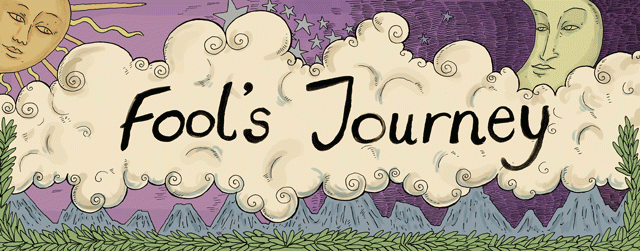
Whilst tarot itself is a popular tool within feminist communities, I personally find that it can be difficult to find a tarot deck that reflects the ethos and principles of feminism. From decks filled with white people to those portraying wearisome traditional gender roles, decks featuring only thin, pretty, able-bodied folks to those rooted in the heteronormative paradigm, decks that feel truly inclusive (which for me is a cornerstone of feminism) are rare finds.
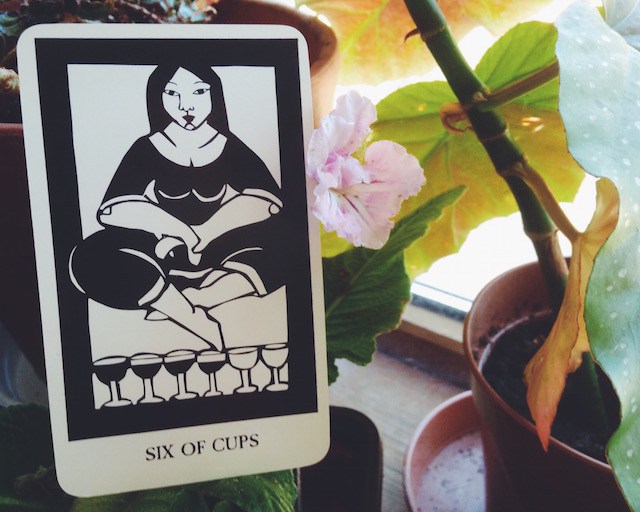
For me, a feminist tarot is one that is inclusive, in every sense of the word. I believe that the 78 cards of the tarot are mirrors of human experiences, so that has to mean all kinds of humans, not just thin, white, straight, cisgender people. I want to see cards that include all genders, and that are diverse in their cultural/ethnic representation. I want decks that encompass different sexualities, relationships and family structures. I want to see different kinds of bodies, fat bodies, disabled bodies, bodies that don’t fit western beauty standards. To be truly considered feminist, for me, a tarot deck needs to be intersectionally feminist, actively challenging the cis-het-white-thin-able paradigm.
And, whilst visual representation is a justly hot topic within the tarot community, as important for me is the presentation of gender and the use of gendered language. I’m tired of tarot books and blogs that talk of the dualities of feminine and masculine, that assign female-looking figures to characteristics like passivity, intuition, nurturing, and male-looking figures to dynamic, extrovert and rule-making archetypes. Pick up any ‘standard’ tarot guidebook and you’ll likely find the Magician is a ‘he’, described as a representation of the ‘masculine principle’ (i.e. an initiator, a firestarter,) whilst their ‘feminine’ counterpart, the High Priestess, is passive, silent, mysterious. Then we get to the Emperor and Empress, the former a ‘father figure’, laying down the laws and concerned with society’s structure, whilst the Empress is often pregnant, and focuses on nourishment, beauty, and taking care of the whole damn world.
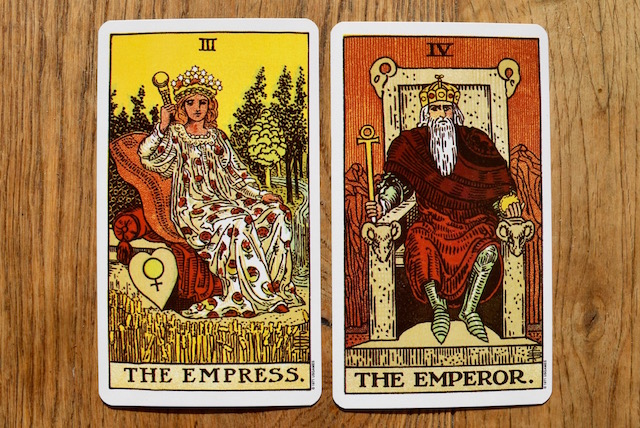
I’m not for one minute dismissing these archetypes or their characteristics. Tarot necessarily encompasses all of these different figures and it’s important that they can appear in our readings — that’s part of what tarot is, how it works. It’s the binary-gendered representations I struggle with. Must we describe Kings as ‘a mature, male figure’? Does the ‘maternal’ Empress really have to be a pregnant woman in order to represent nurturing and fecundity? Can we see a non-binary Magician making shit happen? Could a woman take the Emperor’s throne and lay down the law? Could a queen just as perfectly be represented by a bearded bro?
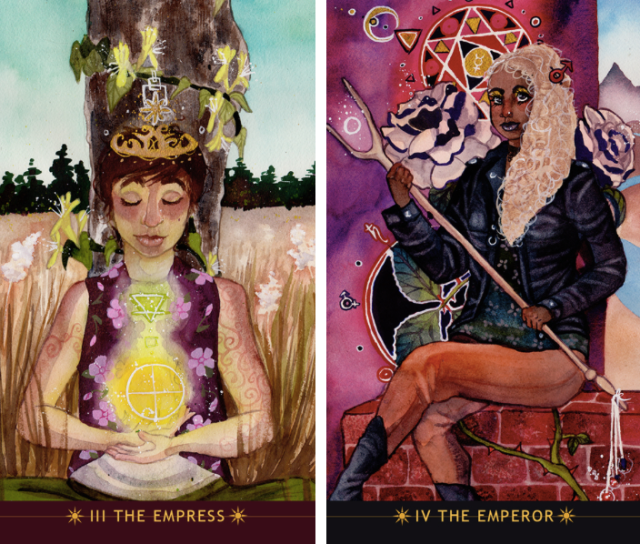
A feminist tarot, for me, is one that joyfully fucks with the gender binary, sidesteps womb/vulva/birth symbology as a defining feature of female power, and consciously moves away from traditional views of feminine and masculine. Ideally, we’d leave behind those words altogether. And before you leap in to the comments to remind me that feminine does not equal female — I know. I get it. And come the revolution maybe we can use those words in a more enlightened way. Right now, looking at mainstream tarot books and decks, I’d say we’re a ways from there yet.
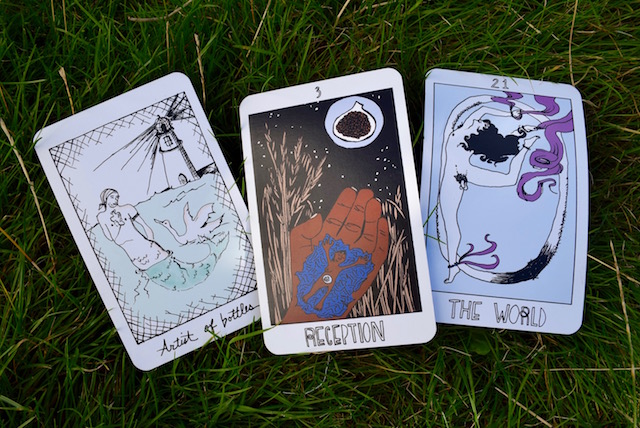
Of course, there are as many approaches to feminist tarot as there are feminist tarot readers — it’s a topic that could and does fill entire books! I consulted a bunch of wonderful feminist tarot readers to share a range of answers to the question ‘what makes a feminist tarot’?
Leah Lakshmi Piepzna-Samarasinha, tarot reader and activist, Brown Star Girl Tarot
I kind of took feminism for a granted a little bit in decks until I started using multiple decks and ran smack into gender binary that makes my eyeballs roll forever. Like, the daughter is “kind” the son is “fierce” — really? It’s all the bad things. I want decks that don’t buy into the gender binary and sexist attributions to what is ‘female’ and ‘male’ but instead presents a rich spectrum of genders. I also want decks that don’t exotify or tokenize trans people or attribute simplistic ideas of “this is what (a particular gender is) is” to cards.
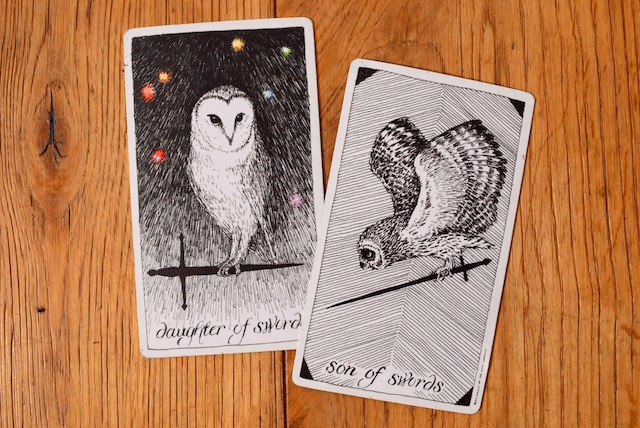
I also want decks where Black and brown folks, disabled folks, poor folks and other folks get to take center stage. I learned on Daughters of the Moon, a “multicultural (second wave cis) feminist deck” that was the only deck I could find that depicted women of color, but where there were no male images except for an “optional” one that of course you could take out if he was too much. That’s not my feminism either. To me, an intersectional queer of color feminist deck will depict life and the world as it is — many gendered, disabled, not very white.
+ Read an interview with Leah about her radical tarot practice here.
Angeliska Polacheck, tarot reader, Sister Temperance Tarot
As a professional tarot reader, it’s hard for me not to perceive the tarot as an intrinsically feminist tool, even if it was not originally intended to be used as such. The essential gifts needed (in my opinion), to be a truly effective tarot reader are empathy and intuition – traits that have always been associated with the feminine energy. The High Priestess rules over these, and is, I believe – the guiding force of the tarot. In many ways, she IS the tarot. The way I work with the cards encourages free will, personal accountability, and having power over your own life. These are all things that women have been robbed of for centuries, and are engaged in a long struggle to regain. I believe that the people who I have the honor of working with get to experience this message through their interaction with the wisdom of the tarot.
There are so many beautiful quintessentially feminist tarot decks out there at this point, (and more being created every day, it seems!) which is so fantastic – but when I sit down to contemplate this question, of course my mind goes back to the incredible work that Pamela Colman Smith and Lady Frieda Harris did in their artwork for the Rider Waite and Thoth decks, respectively. I believe that both of these amazing women channeled their artwork from the divine source as they understood it, and in communing with that power, (both through their individual work) managed to completely revolutionize the tarot as it was then known, in their own unique ways. And of course – they were given little to no credit for this fact, or for their work – until relatively recently. These visionary women changed the way we approach this tool forever, and have inspired and informed countless tarot practitioners and tarot deck creators in the years since, and to come.
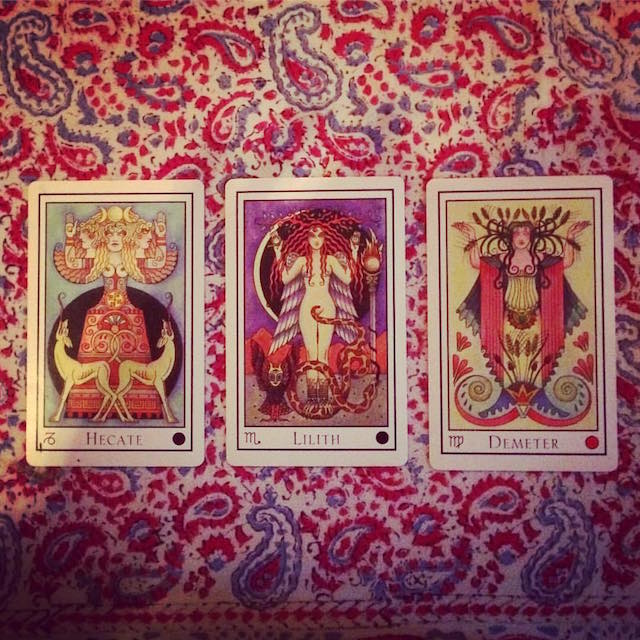
One of my favorite decks is Caroline Smith’s Moon Oracle. Though it is perhaps not designed specifically to be a feminist tarot (or even a proper tarot deck) per se, it is heavy on the Goddess imagery (particularly strong warrior goddesses), includes moon phase cards to “allow the reader to align their life to the fluctuating rhythms of the moon”, and interestingly, lacks court cards with a hierarchy of kings and queens, etc. I love the flowing art deco line-work, and elegant design – and have found it especially helpful for altar meditations, menstrual cycle honoring, and moon ritual.
Asali, cardslinger and healer, Asali Earthwork

Every time I search out a new deck, scrolling through Kickstarter and Indiegogo for up-and-coming decks, a version of this question lingers in the back of my head except it sounds more like I wonder if I can find a deck that looks like me? Tarot decks that draw in from the margins, centering those too often left behind or at the boundaries of community. Decks that show up for black and brown queer femme fat trans disabled folks. Decks that begin from the point of inclusion, where diversity is not an afterthought or throwaway pacifier.
I can’t say I’ve found a deck yet that manages to do all this. I keep a growing note of decks that at least try to meet this bar in someway in my Tarot of the QTPOC list. I live in hope and refuse to believe that it’s too much to ask for. That being said, it’s not all on the deck to do this work. We as readers have our own work to do to strive for intersectional empowering readings for our clients that honor the multiplicity of their identities.
Rima Athar, co-creator of She Is Sitting in the Night: Revisioning Thea’s Tarot
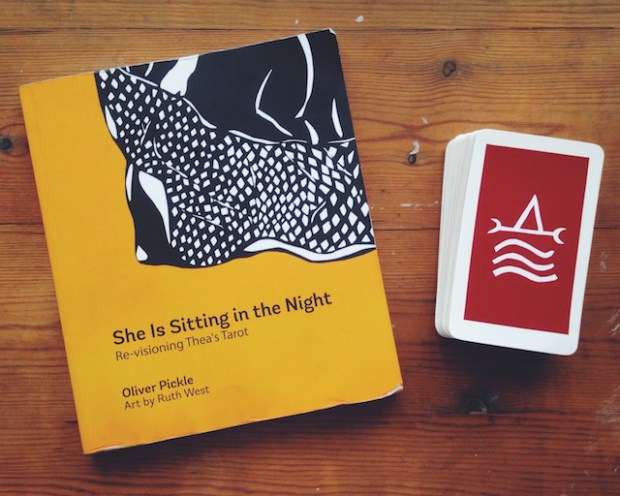
She Is Sitting in the Night is a book that takes the 1984 feminist, lesbian tarot deck Thea’s Tarot, by Ruth West, and revisions it in modern queer terms. (You can read all about that in my review, right here.) It’s the perfect example of a feminist approach to tarot — celebrating the work of another woman, adding fresh perspectives, queerings, reinterpreting for current queer feminism.
From the book’s introduction:
…While I see tarot as a tool for exploring the universal human experience, the mainstream decks I came across were overwhelmingly laden with symbolism and iconography associated with hierarchical European monarchies, with themes of conquest and war, dogmatic Christian religious orthodoxy, and moral overtones. Whilst Strength and the High Priestess in the Major Arcana are often depicted as independent female figures, I was struck by how few women were represented overall in the 78 cards. The Empress is followed by the Emperor, and the four Queens of the Minor Arcana are ultimately subservient to the Kings. In many of the interpretations I came across, the Queens seemed to symbolise either cold and calculating or overly emotional forces to be wary of.
The more I looked at the artwork within various decks, the more the representation seemed to represent a conspicuously absent story. Like so much of history that is rewritten by erasing what came before, I was sure there had to be decks that reflected a different worldview, a feminist worldview.
When I came across archived images of Thea’s Tarot by Ruth West, I knew I had found just that. Here was a deck full of hella-queer women: lesbians in flannel shirts, holding hands, having picnics, writing ideas down, sharing sharing food, gardening and making all kinds of love. Here were women of many shapes and sizes and colors, from historical and contemporary walks of live, basking in the glory of day-to-day life.
I asked Rima to expand on what she wrote in her foreword to the book.
I suppose what resonates from the introduction in relation to this question is probably the parts around challenging overarching structures of oppression, including societies structured around moral hierarchy, and patriarchy, and the general erasure of women —especially powerful, active women — from history. And for me something that’s as important is the recognition and connection to women all over the world in [Thea’s Tarot]. It’s so refreshing to have a deck which portrays all kinds of women with respect.
I also think we have to look at the context & influences & eras in which artworks are made, to get a better understanding of what it may have been saying/alluding to. Whether that’s a version of feminism that resonates or hits all the perspectives we want it to, is a different matter!
Courtney Alexander, creator of the Dust to Onyx Tarot

I believe a Tarot deck is feminist when, as bell hooks says, it is for everybody. We all know that feminism is for everybody and I believe that the same rings true about the tarot. I don’t think the minimum is just about women being liberated — it’s about everybody being liberated. Through the oppression of women and our voices, we have created an imbalance that has not allowed others to fully express that feminine Divine energy in their own lives.
So feminism frees men and frees women; it frees us from gender and sexual expectations. Feminism is about allowing a person to choose who it is that they want to be. Bringing that into tarot means that we should create decks that represent the diversity of the human collective.
Casey Zabala, creator of the Wanderer’s Tarot
A feminist tarot deck is an investigation into the multiplicity of the goddess archetype. Within a feminist tarot she is elevated to her most pure, and felt at her most aggressive. The range of the feminine experience is examined and complemented. The goal of feminist tarot decks is to reclaim the goddess within us all.
When I set out to create my own tarot deck I first chose the suits and court cards which reflects my own vision. I wanted to stray away from traditional gendered archetypes, traditionally found in most other decks, because I understand gender as an evolving aspect of Self — both female and male polarities are alive and working within each of us. Yet, I chose to keep the Queen, and transform her into a Goddess.
The Wanderer’s Tarot became a feminist tarot deck naturally, because I am a feminist. Being a feminist I see all of humanity as deserving of equal opportunity and respect, no matter your experience in the world. As the Goddess guided my creative journey, I was drawn more and more to the feminine form. All the figures in the Wanderer’s Tarot are either female or androgynous.
Having worked with and been inspired by feminist decks such as the Motherpeace Tarot, and the Daughters of the Moon Tarot, I understand these feminist decks read differently. They ask more of your intuition, and inspire you to create your own fresh connections to the symbols and the cards. These feminist decks feel less rigid, and more open to the readers interpretations and stories. It’s as if to remind us that our autonomy matters, and our intuitive abilities are real and strong.
The Wanderer’s Tarot was created with simple, minimalist designs for the same reason — to encourage seekers to forge their own paths, and find their own messages — because we are the magic and the tarot is our mirror through which we seek truth.
Mary Elizabeth Evans, creator of the Spirit Speak Tarot
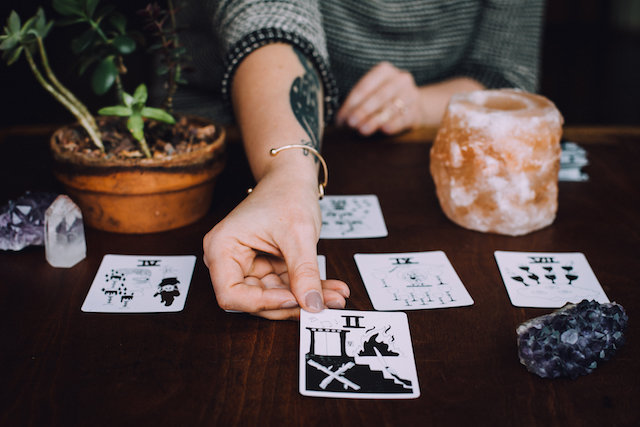
One of the pillars that inspired me to create Spirit Speak was hearing about a group of 25 artist collaborating on a tarot project that focused on including people of color, queer perspectives, people with disabilities, and a multiplicity of genders.
When I first started reading tarot, there was a lot that I didn’t connect with, that didn’t relate to me. Although I can certainly appreciate the beauty and tradition of Pamela Coleman Smith’s artwork in the Rider Waite Tarot Deck, it’s true that it depicts a limited picture of what the world is. After all, the tarot is the story of life through images, and life is ever vast in it’s diversity.
I heard about The Collective Tarot when I was living in Olympia Washington, a town that embraces D.I.Y culture and radical politics. I had been trying to translate tarot to fit my perspective, then realized, tarot could be what I wanted. It was a tool for bettering my mental and emotional health, so I could tailor it to work for me, to talk to me. It was because of those inspirational people and the inspirational place that I was in, that the seed of my new project was planted.
I’m not sure if I know exactly what makes a feminist tarot, but I do know that a good tarot reader has a broad perspective and enters readings without judgement. What I think is really beautiful about tarot right now is that it has a heavy D.I.Y and self publishing element. Tools like Instagram and the internet allow many people access to audiences and the ability to self publish where they might have not had it before. The more voices and the more diversity we can achieve in tarot the better. There is always room for another voice, another interpretation, and each voice that tells their story broadens our understanding of this universal picture.
Rebekah Erev, artist, Hebrew Priestess and creator of the Moon Angel / Malakh Halevanah Oracle Deck
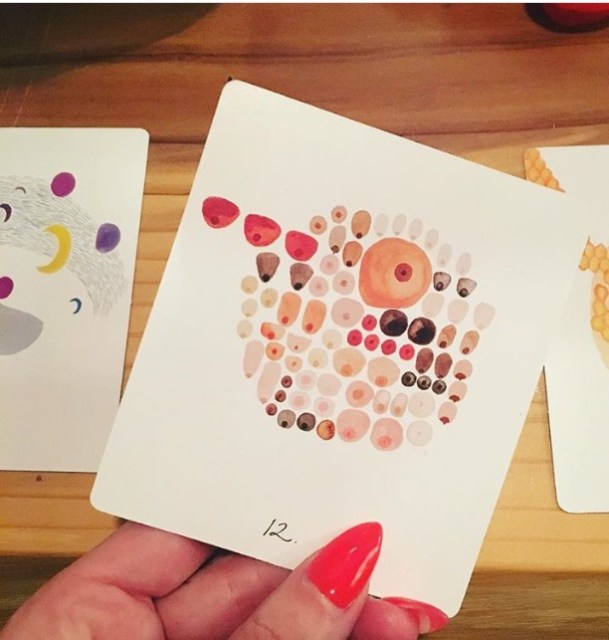
I strongly believe everyone is intuitive. Tarot and oracle decks are inherently feminist because they are a tool to channel our intuition. As humans moved towards societies of agriculture, patriarchy led us further away from honoring our sixth sense. Feminism isn’t that deep: listen to your body and the earth, treat everyone (including yourself) with kindness and dignity, work to restructure society for the liberation of all beings and remember what capitalism has told you to forget. It’s pretty basic.
It’s just that capitalism makes a really strong case on the daily of reminding you to forget what you know and hate what you naturally love (mostly yourself but, everybody else too). For me, the key is to take moments and tap into what’s already there in your atoms. Your atomic memory. Remembering what you already know is the essence of intuition. It’s as important a sense as hearing, tasting, seeing, smelling and touch. In fact, it’s more important because everyone has it. And something we all share is what binds.
As I watch the spread of tarot and oracle decks I can’t help but have hope that we are moving towards a society that wants to dismantle capitalism, envision something else and remember what we know. It’s an accessible, feminist art form. Divination tools give us an opportunity to partner with the universe. When we meet the tools in our lives with our own skills we harness universal truth.
We have a lot of clashing messages pulsing through us each day because of this inner conflict between what we inherently know and what capitalism is trying to drive into our brains and bodies. As the voices of queers, trans people, women of color, people who are intersex, the voices of the disability community and those of us with radical politics emerge we begin to find each other and feel less alone. Feminism is about unlocking the bonds of separation. Seeing everyone as equals and raising up those who have been most oppressed by patriarchy. Tarot and oracle decks support this work because they give us a tool to connect to our atomic memory. A memory that knows the equality of all beings.
+ Read an interview with Rebekah here.
Over to you! What, for you, makes a feminist tarot? And which decks do you consider to meet this definition?







